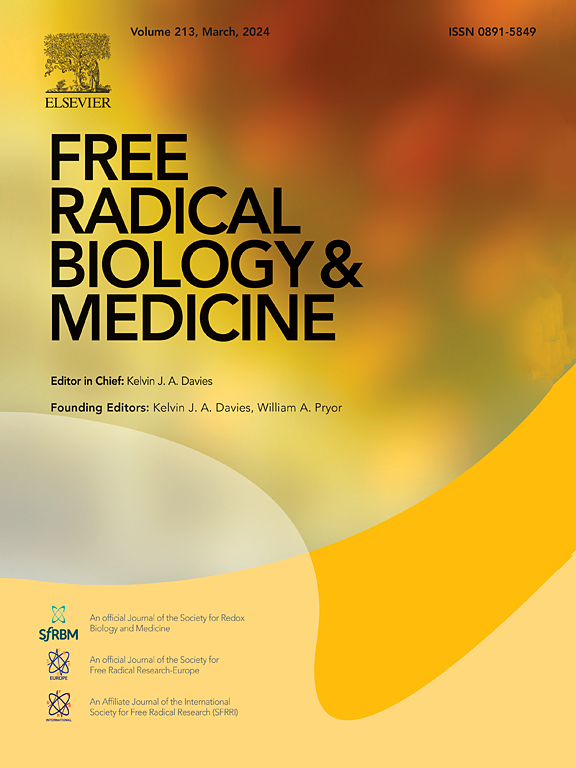Mechanistic insights into cadmium-induced nephrotoxicity: NRF2-Driven HO-1 activation promotes ferroptosis via iron overload and oxidative stress in vitro
IF 7.1
2区 生物学
Q1 BIOCHEMISTRY & MOLECULAR BIOLOGY
引用次数: 0
Abstract
Cadmium (Cd), a pervasive environmental toxicant, poses significant threats to human and animal health through multi-organ toxicity. While ferroptosis has been implicated in Cd-induced pathologies, the molecular mechanisms underlying Cd-mediated nephrotoxicity remain poorly understood. This study elucidates the ferroptosis pathway in CdCl2-exposed PK-15 cells and murine kidney, characterized by iron overload, lipid peroxidation, and mitochondrial dysfunction, which were ameliorated by ferroptosis inhibitor ferrostatin-1. Transcriptomic analysis revealed substantial upregulation of heme oxygenase-1 (HO-1) following CdCl2 exposure. Mechanistically, CdCl2 triggered nuclear translocation of nuclear factor erythroid 2-related factor-2 (NRF2), subsequently activating HO-1 transcription. Over-activated HO-1 catalyzes the decomposition of heme and releases free iron, accompanied with the degradation of ferritin heavy chain 1 (FTH1) induced by CdCl2 exposure, which leads to intracellular iron overload and excessive lipid peroxides production through Fenton reaction, resulting in ferroptosis ultimately. In vivo validation confirmed NRF2/HO-1-mediated ferroptosis in CdCl2-induced murine nephrotoxicity. Both pre-treatment with HO-1 competitive inhibitor Zinc protoporphyrin IX (ZnPP) and knockout of HO-1 gene remarkably alleviated PK-15 cells against ferroptosis induced by CdCl2 treatment. Our findings demonstrate that Cd exposure initiates NRF2-mediated HO-1 overexpression, driving iron-dependent lipid peroxidation and subsequent ferroptosis. This mechanistic insight provides potential therapeutic targets for mitigating Cd-induced renal damage, advancing our understanding of heavy metal toxicity and its cellular consequences.

镉诱导肾毒性的机制:nrf2驱动的HO-1激活通过铁过载和氧化应激促进铁凋亡
镉(Cd)是一种普遍存在的环境毒物,通过多器官毒性对人类和动物健康构成重大威胁。虽然铁下垂与cd诱导的病理有关,但cd介导的肾毒性的分子机制仍然知之甚少。本研究阐明了暴露于cdcl2的PK-15细胞和小鼠肾脏中的铁下垂途径,其特征是铁超载、脂质过氧化和线粒体功能障碍,铁下垂抑制剂铁抑素-1改善了这一途径。转录组学分析显示,CdCl2暴露后血红素氧化酶-1 (HO-1)大幅上调。机制上,CdCl2触发核因子红系2相关因子-2 (NRF2)的核易位,随后激活HO-1转录。过度激活的HO-1催化血红素分解,释放游离铁,同时CdCl2暴露诱导铁蛋白重链1 (FTH1)降解,导致细胞内铁超载,通过Fenton反应产生过多的脂质过氧化物,最终导致铁凋亡。体内验证证实NRF2/ ho -1介导的铁下垂在cdcl2诱导的小鼠肾毒性中。HO-1竞争抑制剂ZnPP预处理和敲除HO-1基因均可显著减轻CdCl2诱导的PK-15细胞铁凋亡。我们的研究结果表明,Cd暴露启动nrf2介导的HO-1过表达,驱动铁依赖性脂质过氧化和随后的铁凋亡。这一机制为减轻cd引起的肾损害提供了潜在的治疗靶点,促进了我们对重金属毒性及其细胞后果的理解。
本文章由计算机程序翻译,如有差异,请以英文原文为准。
求助全文
约1分钟内获得全文
求助全文
来源期刊

Free Radical Biology and Medicine
医学-内分泌学与代谢
CiteScore
14.00
自引率
4.10%
发文量
850
审稿时长
22 days
期刊介绍:
Free Radical Biology and Medicine is a leading journal in the field of redox biology, which is the study of the role of reactive oxygen species (ROS) and other oxidizing agents in biological systems. The journal serves as a premier forum for publishing innovative and groundbreaking research that explores the redox biology of health and disease, covering a wide range of topics and disciplines. Free Radical Biology and Medicine also commissions Special Issues that highlight recent advances in both basic and clinical research, with a particular emphasis on the mechanisms underlying altered metabolism and redox signaling. These Special Issues aim to provide a focused platform for the latest research in the field, fostering collaboration and knowledge exchange among researchers and clinicians.
 求助内容:
求助内容: 应助结果提醒方式:
应助结果提醒方式:


